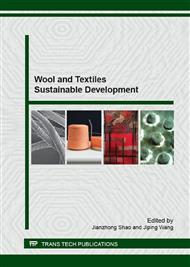[1]
Ciurczak, E.W., Handbook of Near-Infrared Analysis, Marcel Dekker, SA, New York, (1992).
Google Scholar
[2]
Moron, A., et al., Application of near infrared reflectance spectroscopy for the analysis of organic C, total N and pH in soils of Uruguay. Journal of near infrared spectroscopy, 2002. 10. (3): pp.215-222.
DOI: 10.1255/jnirs.338
Google Scholar
[3]
Teye, E., et al., Estimating cocoa bean parameters by FT-NIRS and chemometrics analysis. Food Chemistry, 2015. 176: pp.403-410.
DOI: 10.1016/j.foodchem.2014.12.042
Google Scholar
[4]
Alves, J.C., et al., Biodiesel content determination in diesel fuel blends using near infrared (NIR) spectroscopy and support vector machines (SVM). Talanta, 2013. 104: pp.155-161.
DOI: 10.1016/j.talanta.2012.11.033
Google Scholar
[5]
Galvão, R.K.H., et al., An application of subagging for the improvement of prediction accuracy of multivariate calibration models. Chemometrics and Intelligent laboratory systems, 2006. 81(1): pp.60-67.
DOI: 10.1016/j.chemolab.2005.09.005
Google Scholar
[6]
Alvarenga, L., et al., Tablet identification using near-infrared spectroscopy (NIRS) for pharmaceutical quality control. Journal of pharmaceutical and biomedical analysis. 2008. 48 (1): pp.62-69.
DOI: 10.1016/j.jpba.2008.05.007
Google Scholar
[7]
Haffner, F.B., et al., Compositional analysis of Miscanthus giganteus by near infrared spectroscopy. Cellulose, 2013. 20(4): pp.1629-1637.
DOI: 10.1007/s10570-013-9935-1
Google Scholar
[8]
Jiang, H., et al. Identification of solid state fermentation degree with FT-NIR spectroscopy: Comparison of wavelength variable selection methods of CARS and SCARS. Spectrochimica Acta Part A: Molecular and Biomolecular Spectroscopy , (2015).
DOI: 10.1016/j.saa.2015.04.024
Google Scholar
[9]
Yotsuda, T., et al., Near infrared spectral imaging for water absorbency of woven fabrics. Instrumentation and Measurement Technology Conference, 2004. IMTC 04. Proceedings of the 21st IEEE. Vol. 3. IEEE, (2004).
DOI: 10.1109/imtc.2004.1351542
Google Scholar
[10]
Canaza-Cayo, A. W., et al., A feasibility study of the classification of Alpaca (Lama pacos) wool samples from different ages, sex and color by means of visible and near infrared reflectance spectroscopy. Computers and Electronics in Agriculture, 2012, 88: pp.141-147.
DOI: 10.1016/j.compag.2012.07.013
Google Scholar
[11]
Zoccola, M., et al., Identification of wool, cashmere, yak, and angora rabbit fibers and quantitative determination of wool and cashmere in blend: a near infrared spectroscopy study. Fibers and Polymers, 2013. 14(8): pp.1283-1289.
DOI: 10.1007/s12221-013-1283-0
Google Scholar
[12]
Church, J. S., et al., A comparison of vibrational spectroscopic methods for analyzing wool/polyester textile blends. Textile research journal, 1999. 69(9): pp.676-684.
DOI: 10.1177/004051759906900908
Google Scholar
[13]
Durand, A., et al. Genetic algorithm optimisation combined with partial least squares regression and mutual information variable selection procedures in near-infrared quantitative analysis of cotton–viscose textiles. Analytica Chimica Acta, 2007. 595(1): pp.72-79.
DOI: 10.1016/j.aca.2007.03.024
Google Scholar
[14]
Sohn, M., et al., Fourier transform near-infrared spectroscopy for determining linen content in linen/cotton blend products. Textile research journal, 2005. 75(8): pp.583-590.
DOI: 10.1177/0040517505057167
Google Scholar
[15]
Canaza-Cayo, A. W., et al., Prediction of alpaca fibre quality by near-infrared reflectance spectroscopy. Animal, 2013 7(7): 1219-1225.
DOI: 10.1017/s1751731113000505
Google Scholar
[16]
Blanco, M., et al. Use of near-infrared spectrometry in control analyses of acrylic fibre manufacturing processes. Analytica chimica acta. 1999. 383(3): pp.291-298.
DOI: 10.1016/s0003-2670(98)00804-6
Google Scholar
[17]
Gishen, M., et al., Feasibility study on the potential of visible and near infrared reflectance spectroscopy to measure alpaca fibre characteristics. Animal, 2007. 1. (6): pp.899-904.
DOI: 10.1017/s1751731107000146
Google Scholar
[18]
Yan, J.J., et al., Characterization of degradation of cotton cellulosic fibers through near infrared spectroscopy. Journal of Polymers and the Environment, 2013. 21(4): pp.902-909.
DOI: 10.1007/s10924-013-0605-z
Google Scholar
[19]
Chen, C.H., et al., Non–destructive near–infra–red analysis for the identification of dyes on textiles. Journal of the Society of Dyers and Colourists, 1997. 113(2): pp.51-56.
DOI: 10.1111/j.1478-4408.1997.tb01867.x
Google Scholar
[20]
Sekulic, S., et al. Nonlinear multivariate calibration methods in analytical chemistry. Analytical Chemistry, 1993. 65(19): p. 835A-845A.
DOI: 10.1021/ac00067a714
Google Scholar
[21]
Barnes, R. J., et al., Standard normal variate transformation and de-trending of near-infrared diffuse reflectance spectra. Applied spectroscopy, 1989. 43(5): pp.772-777.
DOI: 10.1366/0003702894202201
Google Scholar
[22]
Isaksson,T., et al., The effect of multiplicative scatter correction (MSC) and linearity improvement in NIR spectroscopy. Applied Spectroscopy, 1988. 42(7): pp.1273-1284.
DOI: 10.1366/0003702884429869
Google Scholar
[23]
Information on http: /en. wikipedia. org/wiki/Soft_independent_modelling_of_class_analogies.
Google Scholar
[24]
Smith, B.C., et al. Infrared spectral interpretation: a systematic approach. CRC press, (1998).
Google Scholar
[25]
Coleman, S.W., et al., Prediction of clean mohair, fiber diameter, vegetable matter, and medullated fiber with near-infrared spectroscopy. Journal of animal science, 1999. 77: pp.2594-2602.
DOI: 10.2527/1999.77102594x
Google Scholar


